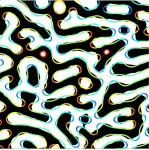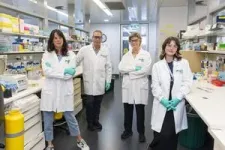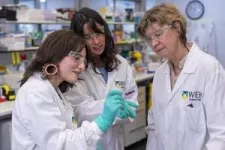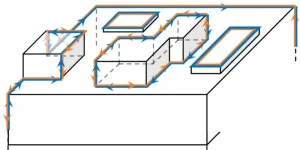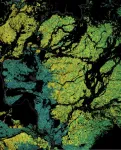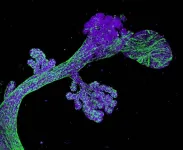(Press-News.org) A discovery from an experiment with magnets and lasers could be a boon to energy-efficient data storage.
“We wanted to study the physics of light-magnet interaction,” said Rahul Jangid, who led the data analysis for the project while earning his Ph.D. in materials science and engineering at UC Davis under associate professor Roopali Kukreja. “What happens when you hit a magnetic domain with very short pulses of laser light?”
Domains are areas within a magnet that flip from north to south poles. This property is used for data storage, for example in computer hard drives.
Jangid and his colleagues found that when a magnet is hit with a pulsed laser, the domain walls in the ferromagnetic layers move at a speed of approximately 66 km/s, which is about 100 times faster than the speed limit previously thought.
Domain walls moving at this speed could drastically affect the way data is stored and processed, offering a means of faster, more stable memory and reducing energy consumption in spintronic devices such as hard disk drives that use the spin of electrons within magnetic metallic multilayers to store, process or transmit information.
“No one thought it was possible to move these walls that fast because they should hit their limit,” said Jangid. “It sounds absolutely bananas, but it’s true.”
It’s “bananas,” because of the Walker breakdown phenomenon, which says that domain walls can only be pushed so far at a given velocity before they effectively break down and stop moving. This research, however, gives evidence that the domain walls can be driven at previously unknown velocities using lasers.
While most personal devices like laptops and cell phones use faster flash drives, data centers use cheaper, slower hard disk drives. However, each time a bit of information is processed, or flipped, the drive uses a magnetic field to conduct heat through a coil of wire, burning a lot of energy. If, rather, a drive could use laser pulses on the magnetic layers, the device would operate at a lower voltage and bit flips would take significantly less energy to process.
Current projections indicate that by 2030, information and communications technology will account for 21% of the world’s energy demand, exacerbating climate change. This finding, which was highlighted in a paper by Jangid and co-authors titled “Extreme Domain Wall Speeds under Ultrafast Optical Excitation” in the journal Physical Review Letters on Dec. 19, comes at a time when finding energy-efficient technologies is paramount.
When laser meets magnet
To conduct the experiment, Jangid and his collaborators, including researchers from the National Institute of Science and Technology; UC San Diego; University of Colorado, Colorado Springs and Stockholm University used the Free Electron Laser Radiation for Multidisciplinary Investigations, or FERMI facility, a free electron laser source based in Trieste, Italy.
“Free electron lasers are insane facilities,” Jangid said. “It’s a 2-mile-long vacuum tube, and you take a small number of electrons, accelerate them up to the speed of light, and at the end wiggle them to create X-rays so bright, that if you’re not careful, your sample could be vaporized. Think of it like taking all the sunlight falling on the Earth and focusing it all on a penny — that’s how much photon flux we have at free electron lasers.”
At FERMI, the group utilized X-rays to measure what occurs when a nano-scale magnet with multiple layers of cobalt, iron and nickel is excited by femtosecond pulses. A femtosecond is defined as 10 to the negative 15th of a second or one-millionth of one-billionth of a second.
“There are more femtoseconds in one second than there are days in the age of the universe,” Jangid said. “These are extremely small, extremely fast measurements that are difficult to wrap your head around.”
Jangid, who was analyzing the data saw that it was these ultrafast laser pulses exciting the ferromagnetic layers that resulted in the movement of the domain walls. Based on how fast those domain walls were moving, the study posits that these ultrafast laser pulses can switch a stored bit of information approximately 1,000 times faster than the magnetic field or spin current-based methods being used now.
The future of ultrafast phenomena
The technology is far from being practically applied, as current lasers consume a lot of power. However, a process similar to the way compact discs, or CDs, use lasers to store information and CD players use lasers to play it back could potentially work in the future, Jangid said.
The next steps include further exploring the physics of mechanisms that enable ultrafast domain wall velocities higher than the previously known limits, as well as imaging the domain wall motion.
This research will continue at UC Davis under Kukreja. Jangid is now pursuing similar research at National Synchrotron Light Source 2 at Brookhaven National Laboratory.
“There are so many aspects of ultrafast phenomenon that we are just starting to understand,” Jangid said. “I'm eager to tackle the open questions that could unlock transformative advancements in low power spintronics, data storage, and information processing.”
END
Ultrafast laser pulses could lessen data storage energy needs
2024-01-16
ELSE PRESS RELEASES FROM THIS DATE:
Tests can reveal whether an antibody can turn into a killer
2024-01-16
What makes a soldier switch sides? That is a really good question. Especially when the soldier is an antibody that is supposed to defend the body against one of the world's most dangerous snake venoms but instead ends up helping the venom kill the body.
The question has become topical after a group of DTU researchers slightly changed how they tested an antibody that had previously proven promising as an antidote to snake venom. In the first experiment on mice, the damaging effect on muscle tissue from the venom of Bothrops Asper, ...
The surface knows what lies beneath: physicists show how to detect higher-order topological insulators
2024-01-16
Just like a book can’t be judged by its cover, a material can’t always be judged by its surface. But, for an elusive conjectured class of materials, physicists have now shown that the surface previously thought to be “featureless” holds an unmistakable signature that could lead to the first definitive observation.
Higher-order topological insulators, or HOTIs, have attracted attention for their ability to conduct electricity along one-dimensional lines on their surfaces, but this property is quite difficult to experimentally distinguish from other ...
Dr. Marcus D. Goncalves inducted into the American Society for Clinical Investigation
2024-01-16
Dr. Marcus D. Goncalves Inducted into the American Society for Clinical Investigation
Dr. Marcus D. Goncalves, the Ralph L. Nachman, M.D. Research Scholar and an assistant professor of medicine in the Division of Endocrinology, Diabetes and Metabolism at Weill Cornell Medicine, has been elected as a member of the American Society for Clinical Investigation (ASCI) for 2024.
The ASCI is one of the nation’s oldest nonprofit medical honor societies and focuses on the unique role of physician-scientists in research, clinical care and medical education. It is comprised of more than 3,000 physician-scientists representing ...
Method improves detection of potential therapeutic tumor targets in human biopsies
2024-01-16
Many cancers, including some types of breast cancer, are driven by alterations in the activity of cellular enzymes called kinases. Therapies that directly inhibit these cancer-promoting activities have proven to be effective for patients in which individual driving kinases can be diagnosed.
One major challenge to this therapeutic approach is to accurately quantify tumor kinases in human biopsy samples. Many kinases are not abundantly present and are therefore more difficult to measure accurately. Although currently there are methods to quantify small amounts of kinases, measuring multiple kinases ...
Canadian Science Publishing goes live on OA switchboard
2024-01-16
As part of our open science strategy, Canadian Science Publishing (CSP) is pleased to announce our new partnership with OA Switchboard, a mission-driven, community led initiative designed to simplify the sharing of information between stakeholders about open access publications throughout the whole publication journey.
“We’re thrilled to partner with the OA Switchboard to improve the visibility of the work we publish,” says Elaine Stott, Chief Executive Officer of CSP. “This initiative enables institutions, consortia and funders to report ...
A new, rigorous assessment of OpenET accuracy for supporting satellite-based water management
2024-01-16
Sustainable water management is an increasing concern in arid regions around the world, and scientists and regulators are turning to remote sensing tools like OpenET to help track and manage water resources. OpenET uses publicly available data produced by NASA and USGS Landsat and other satellite systems to calculate evapotranspiration (ET), or the amount of water lost to the atmosphere through soil evaporation and plant transpiration, at the level of individual fields. This tool has the potential to revolutionize water management, allowing for field-scale ...
Multisite clinical trial will compare three FDA-approved drugs for Rett syndrome treatment
2024-01-16
Vanderbilt University Medical Center received a $13 million Department of Defense grant to lead a multisite clinical trial that will evaluate repurposed FDA-approved drugs as treatment options for patients with Rett syndrome.
Affecting 1 in 10,000 females at birth, and males even more rarely, Rett syndrome is a rare genetic neurodevelopmental disorder that affects brain development.
“It robs affected individuals of the ability to use their hands or speak and causes problems with mobility, as well as a number of other issues,” said Jeffrey Neul, Annette Schaffer Eskind Professor, ...
St. Jude Home Care, LLC is first US pediatric home health agency to earn new category of industry certification
2024-01-16
St. Jude Children’s Research Hospital announces today that St. Jude Home Care LLC, a home health agency for the hospital’s patients, earned dual certifications in both pediatrics and home health from Community Health Accreditation Partners (CHAP), an independent, non-profit, accrediting body for home and community-based healthcare organizations. St. Jude Home Care LLC is the nation’s first agency to achieve that distinction. CHAP is the only organization in the U.S. that grants a discrete pediatric certification ...
Study pinpoints breast cancer ‘cells-of-origin’ in high-risk women
2024-01-16
Australian scientists have pinpointed likely ‘cells-of-origin’, the source cells that can grow into breast cancer, in women carrying a faulty BRCA2 gene who are at high risk of developing the disease.
The WEHI-led study also showed these cells have potential to be targeted with an existing cancer drug to delay tumour growth, in findings that may lead to future preventive treatments for the disease.
At a glance
Women with faulty BRCA2 genes are at a substantially higher risk of developing breast ...
Supports help keep Aussie firefighters safe
2024-01-16
House fires, road crashes and emergency rescues – they’re all part of the job for Aussie firefighters. And in such physically demanding roles, maintaining a high level of fitness and movement quality is essential.
Now, new research from health and fitness experts at the University of South Australia shows that professional firefighters have reduced movement quality as they age, which could put them at greater risk of injury.
Conducted by UniSA masters researcher, Alex Redshaw, in partnership with the South Australian Metropolitan Fire Service (MFS), the findings indicate that firefighters over the age of 50 generally have lower movement ...
